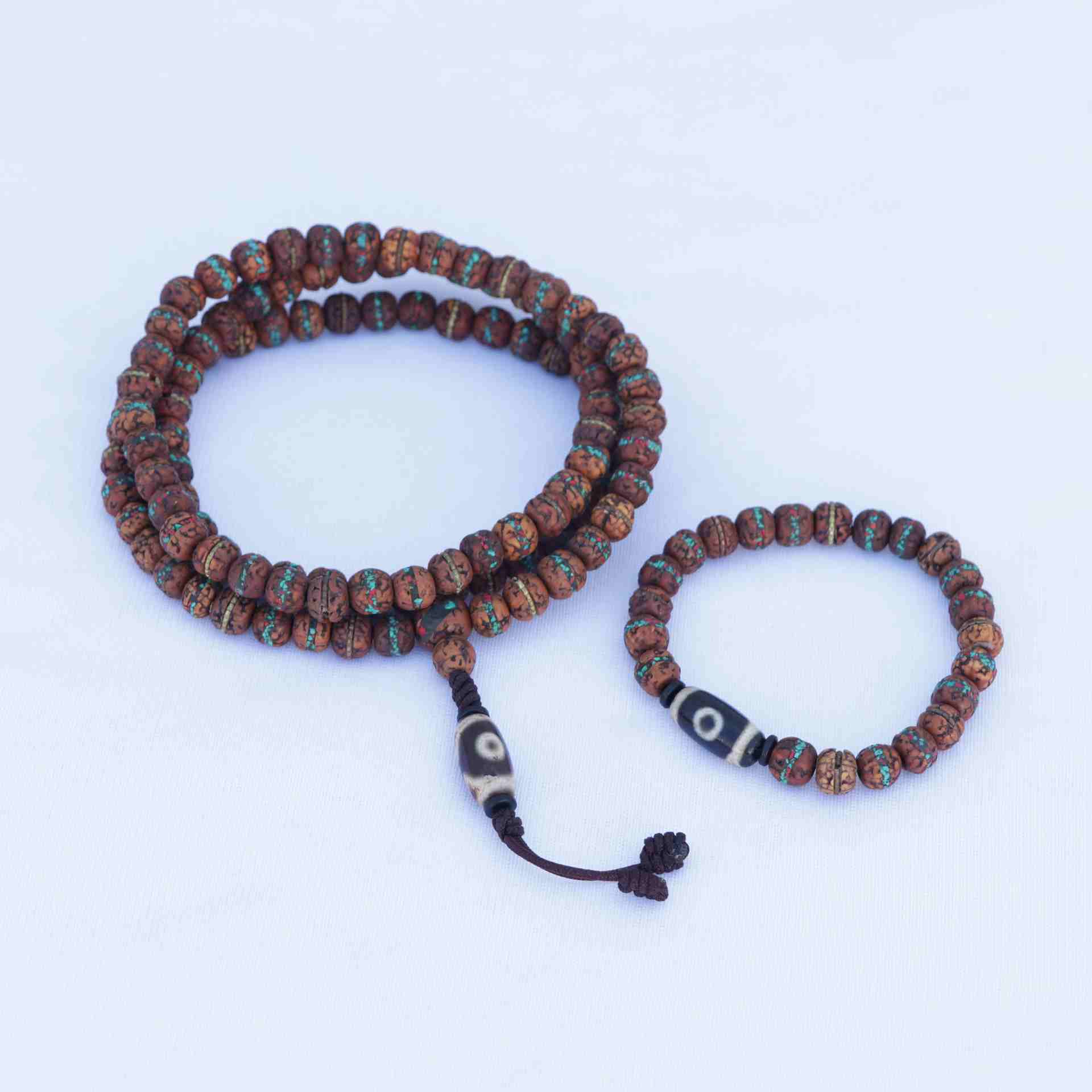Rudraksha, also known as Rudraksh, is a popular seed bead used in a wide range of activities. These iconic beads have been used since ancient times to the modern day. While the specific use of these rudraksha beads has varied across the ages, they still remain iconic to this day. However, have you ever wondered what these seed beads are? Do you know what its type is? Do you want to know all about Rudraksha?
In this blog, we talk about various aspects of Rudraksha, including their types, a brief on different mukhis, and how to care for them. So, with this in mind, let’s get started!
What is a Rudraksha?
A Rudraksha or Rudraksha is a seed that is taken from the fruit of the Rudraksha tree. This tree is botanically known as Elaeocarpus Ganitrus. The seeds are dried and then cleaned before being used in accessories such as Rudraksha Mala Necklace and Rudraksha Wrist Mala Bracelets.
The name Rudraksha is a combination of two Sanskrit words, “Rudra” and “Aksha.” Rudra is one of the many names of Lord Shiva, and Aksha translates to “Eye,” “Tears,” or “Gift.” Therefore, the term rudraksha can have three different meanings. These meanings are as follows:
- Eye of lord Shiva
- Tears of lord Shiva
- Gift of lord Shiva
Regardless of the meaning, the Rudraksha beads are deeply associated with lord Shiva.
These beads have an iconic and unique appearance and are popular among both fashionable and spiritual users globally. Furthermore, there are various types of Rudraksha. Along with the various types, there are also different Mukhi Rudrakshas.
What are the types of Rudraksha beads?

When we think of Rudraksha beads, we generally have an image of a seed bead that has split faces. However, Rudraksha is not just a single type of seed beads. There are several different types of Rudraksha mala beads. The benefits of rudraksha mala and rudraksha wrist mala vary depending on these types. These various types of Rudraksha beads are as follows:
Gauri Shankar
Gauri Shankar Rudraksha is a type of bead that is formed by the natural conjoining of two beads. Anyone above the age of 14 can wear these Rudraksha beads. Furthermore, this bead has its own significance. It is associated with the balancing of the Ida and Pingala. Additionally, this type of Rudraksha is also considered the most authoritative type. The reason behind this is that it represents the completeness of Gauri Shankar, which signifies the union of masculine and feminine aspects. Here, the Shankar (another name for lord Shiva) signifies the masculine, and Shakti (another name for lord Parvati) signifies the feminine aspect.
Sawarare Gauri Shankar
Similar to Gauri Shankar, The Sawarare Gauri Shankar Rudrakha is also a conjoint Rudraksha. This type of Rudraksha signifies the aspects of unity, love, peace, and prosperity. Along with this, the Sawarare Gauri Shankar Rudraksha also signifies joy and everlasting blessings. Using this Rudraksha is said to enhance the growth in business, self-development, and various aspects of life. This Rudraksha also enhances the familial bond and relationships.
Ganesha
Ganesha Rudraksha is the Rudraksha that is shaped like an elephant with a trunk-like protrusion. As you can guess, it is a fairly rare type of Rudraksha. Therefore, wearing this seed bead is said to remove all the hardships in your life. As you can guess from the name of this Rudraksha, its ruling lord is Lord Ganesha, and wearing it blesses you with the grace of lord Ganesha.
Trijuti
Trijuti Rudraksha is a rare type of Rudraksha bead that has three conjoint Rudraksha beads. This is a fairly rare type, and it represents the holy trinity of Hinduism. The holy trinity includes lord Brahma, Vishnu, and Mahesh (another name for lord Shiva). Wearing this seed bead grants you the blessings of all three lords. The blessings include a boost of fortune, happiness, and protection from evil forces. Furthermore, Trijuti Rudraksha also aids leaders in developing charismatic personalities.
Savar Naag Rudraksha
These are the conjoint seeds where one aspect is smaller than the rest, giving it the look of a snake raising its head. This bead is associated with lord Shiva, and it is a rare type of Rudraksha. These beads are considered rather powerful. Therefore, wearing accessories made from or with this seed bead is considered extremely helpful.
Other Types
Besides the ones we mentioned here, there are two other types. These are Dawita and Veda. The Dawita has four conjoined sawars. Furthermore, the term Dawita refers to the duality.
Similarly, the Veda also has four conjoined sawars and is associated with the ancient Hindu scriptures.
There are further unusual forms with two conjoined sawars. These variations, with two conjoined segments, add to the diversity of Rudraksha beads. The specifics of these unique forms may carry distinct significance within certain spiritual or cultural contexts.
Different Mukhi Rudraksha

Along with the various types, Rudraksha can also be categorized based on its mukhi/munkhi as well. There are twenty-one different mukhis of Rudraksha. Each mukhi of Rudraksha has its ruling lord, ruling planet, and beeja mantra. They are as follows.
| Mukhi Rudraksha | Ruling Lord | Ruling Planet | Beeja Mantra |
| One | Shiva | All | Om Namah Shivaye |
| Two | Ardhanareshwar | Moon | Om Namah |
| Three | Agni | Sun | Om Kleem Namah |
| Four | Brahaspati | Jupiter | Om Hreem Namah |
| Five | Rudra Kalagni | Jupiter | Om Hreem Namah |
| Six | Kartikeya | Mars | Om Hreem Hoom Namah |
| Seven | Laxmi | Venus | Om Hoom Namah |
| Eight | Ganesh | Ketu | Om Hoom Namah |
| Nine | Durga | Ketu | Om Hreem Hoom Namah |
| Ten | Krishna | All | Om Hreem Namah Namah |
| Eleven | 11 Rudras | All | Om Hreem Namah Namah |
| Twelve | Sun | Sun | Om Kraum Ksaum Raum Namah |
| Thirteen | Kamadeva | Venus | Om Hreem Namah |
| Fourteen | Hanuman | Mars | Om Namah |
| Fifteen | Lord Pashupatinath | Mercury | Om Hreem Namah |
| Sixteen | Mahamritunjaya Shiva | Moon | Om Hreem Hoom Namah |
| Seventeen | Katyayani Devi | saturn | Om Hreem Hoom Namah |
| Eighteen | Bhumi Devi | Earth | Om Hreem Shreem Vasudhaye Swaha |
| Nineteen | Lord Narayana | Mercury | Om Vam Vishnave Shreeshayane Swaha |
| Twenty | Brahma | Earth | Rudrarupaye Kalpante Namastubhyan Trimurtaye |
| Twenty-One | Kubera | Earth | Om Yakshaya Kuberaya Vaishravanaya, Dhan Dhanyadhipataye, Dhan Dhanya Srimdhim mein Dapya Dapya Swaha |
Religious use of Rudraksha
Now that you know the different types and mukhis of Rudraksha, you may already have some idea regarding the religious use of the Rudraksha. However, you may still want to know the specific religious use. Some of these uses are as follows:
- Prayer Beads
- Meditation Aid
- Offerings during Worship and Puja
- Symbolic Jewelry
- Aid in Spiritual Healing
- Yoga and Spiritual Practices
Besides the ones we mentioned here, the specific religious use can vary depending on the beliefs and cultures of your religion and sect. Regardless, people from various spiritual backgrounds and beliefs embrace Rudraksha for its perceived holistic and metaphysical properties.
Caring for your Rudraksha Beads

After talking about the types, mukhis, and the religious use of Rudraksha, let’s quickly talk about some methods to care for Rudraksha before we conclude. Now, there are many methods to wear and care for rudraksha beads. Therefore, the specifics vary depending on the individual. However, some guidelines on how to care for Rudraksha beads are as follows:
- Keep the Rudraksha clean. For this, you can occasionally wipe the Rudraksha with a soft, clean cloth.
- Remove these beads while doing activities associated with water, as these beads can absorb water.
- Apply a small amount of natural oil like sandalwood oil or coconut oil periodically.
- Keep these beads away from extreme temperatures.
- Keep the beads in a clean, dry place when not in use.
- Periodically energize rudraksha beads by placing them in a bowl of clean water with a few drops of oil.
These are just some of the ways to take care of the Rudraksha. That said, the specifics can vary depending on your religion or sect.
Conclusion
Rudraksha is an iconic seed bead that is used for a wide range of purposes. They are ideal seed beads for worshippers of lord Shiva, and their iconic look makes them ideal as a fashion accessory. That said, the specific use of the Rudraksha does vary depending on its type. Besides the commonly seen single-beaded Rudraksha, there are seven types and twenty-one mukhis of Rudraksha. Each of these types and mukhis has its own significance and importance. Furthermore, these beads also have religious uses. That said, to make the most of Rudraksha, you should take care of these beads.
In this blog, we talked about the various mukhis, types, uses, and ways to take care of the Rudraksha.
We hope you found this interesting and helpful. If you want further insight into the world of various spiritual accessories, do check out some of our other blogs. If you want the best Rudraksha Mala, then do check us out at Nirvana Mala, experts at handicrafts in Nepal. And as always, thank you for reading till the end.
FAQ on Rudraksha Beads
Q: What is special about Rudraksha?
A: Rudraksha beads are special due to their spiritual significance in Hinduism, association with Lord Shiva, diverse types (mukhis), and use as prayer beads.
Q: What are the rules for wearing Rudraksha?
A: The specific rules for wearing Rudraksha vary depending on your religion and sect. However, some common rules are as follows:
- Ensure the Rudraksha beads are genuine and untampered.
- Choose beads based on personal goals; different mukhis have specific properties.
- Wear Rudraksha close to the skin, typically as a necklace or bracelet.
- Keep the beads clean and avoid exposure to water, especially during bathing.
- Periodically energize the beads through rituals or by placing them in clean water with a few drops of oil.

